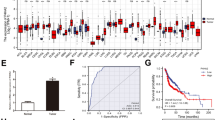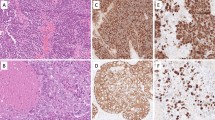Abstract
To explore the influence of chemotherapy on prognosis of Head and Neck Squamous Cell Carcinoma (HNSCC) and the relationship between XIAP and CIAP1 co-expression and the prognosis in HNSCC. 129 patients were recruited in our study, they were divided into two groups, neoadjuvant group (n = 60) and non-neoadjuvant group (n = 69). Expression level of XIAP and CIAP1 were examed in neoadjuvant group, and was correlated with clinical outcomes of the patients. The unselected patients were not benefit from neoadjuvant chemotherapy. Moreover, the patients whose tumors co-express high level of XIAP and CIAP1 presented poorer overall and disease-free survival rates than those whose tumors co-express low level of XIAP and CIAP1 (overall survival P < 0.001, disease-free survival P < 0.001). Our results validate that individual chemotherapy is important for HNSCC, and co-expression of XIAP and CIAP1 prompted a worse prognosis.





Similar content being viewed by others
References
Greenlee RT, Hill-Harmon MB, Murray T, Thun M (2001) Cancer statistics. CA Cancer J Clin 51(1):15–36
Chen Z, Seimiya H, Naito M, Mashima T, Kizaki A, Dan S, Imaizumi M, Ichijo H, Miyazono K, Tsuruo T (1999) ASK1 mediates apoptotic cell death induced by genotoxic stress. Oncogene 18(1):173–180
Mase H, Sasaki A, Alcalde RE et al (2000) Regulation of apoptasis reduction in the cisplatin-resistant cell line by Bcl-2 and CPP32. Chemotherapy 46:69–76
Nakano Y, Bilim V, Yuuki K, Muto A, Kato T, Nagaoka A, Tomita Y (2009) Molecular targeting of Bcl-2 overcomes prostate cancer cell adaptation to XIAP gene down regulation. Prostate Cancer Prostatic Dis 12(1):34–40
McManus DC, Lefebvre CA, Cherton-Horvat G, St-Jean M, Kandimalla ER, Agrawal S, Morris SJ, Durkin JP, LaCasse EC (2004) Loss of XIAP protein expression by RNAi and antisense approaches sensitizes cancer cells to functionally diverse chemotherapeutics. Oncogene 23:8105–8117
Tamm I, Trepel M, Cardo-Vila M et al (2003) Peptides targeting caspase inhibitors. J Biol Chem 278:14401–14405
Ma J-j, Chen B-l, Xin X-y (2009) XIAP gene downregulation by small interfering RNA inhibits proliferation, induces apoptosis, and reverses the cisplatin resistance of ovarian carcinoma. Eur J Obstet Gynecol Reprod Biol 146:222–226
LaCasse EC, Mahoney DJ, Cheung HH et al (2008) IAP-targeted therapies for cancer. Oncogene 27:6252–6275
Reed JC (2001) The survivin saga goes in vivo. J Clin Invest 108:965–969
Morizane Y, Honda R, Fukami K, Yasuda H (2005) X-linked inhibitor of apoptosis functions as ubiquitin ligase toward mature caspase-9 and cytosolic Smac/DIABLO. J Biochem (Tokyo) 137:125–132
Scott FL, Denault JB, Riedl SJ, Shin H, Renatus M, Salvesen GS (2005) XIAP inhibits caspase-3 and-7 using two binding sites: evolutionarily conserved mechanism of IAPs. EMBO J 24:645–655
Suzuki Y, Nakabayashi Y, Takahashi R (2001) Ubiquitin-protein ligase activity of X-linked inhibitor of apoptosis protein promotes proteasomal degradation of caspase-3 and enhances its anti-apoptotic effect in Fas-induced cell death. Proc Natl Acad Sci U S A 98:8662–8667
Holcik M, Gibson H, Korneluk RG (2001) XIAP: apoptotic brake and pro-mising therapeutic target. Apoptosis 6:253–261
LaCasse EC, Baird S, Korneluk RG, MacKenzie AE (1998) The inhibitors of apoptosis (IAPs) and their emerging role in cancer. Oncogene 17:3247–3259
Hu YP, Cherton-Horvat G, Dragowska V et al (2003) Antisense oligonucleotides targeting XIAP induce apoptosis and enhance chemotherapeutic activity against human lung cancer cells in vitro and in vivo. Clin Cancer Res 9:2826–2836
Amantana A, London CA, Iversen PL, Devi GR (2004) X-linked inhibitor of apoptosis protein inhibition induces apoptosis and enhances chemotherapy sensitivity in human prostate cancer cells. Mol Cancer Ther 3(6):699–707
Tirrò E, Consoli ML, Massimino M, Manzella L, Frasca F, Sciacca L, Vicari L, Stassi G, Messina L, Messina A, Vigneri P (2006) Altered expression of c-IAP1, survivin, and Smac contributes to chemotherapy resistance in thyroid cancer cells. Cancer Res 66(8):4263–4272
Yang XH, Feng ZE, Yan M, Hanada S, Zuo H, Yang CZ, Han ZG, Guo W, Chen WT, Zhang P (2012) XIAP is a predictor of cisplatin-based chemotherapy response and prognosis for patients with advanced head and neck cancer. PLoS One 7(3):e31601
Licitra L, Grandi C, Guzzo M, Mariani L, Lo Vullo S et al (2003) Primary chemotherapy in resectable oral cavity squamous cell cancer: a randomized controlled trial. J Clin Oncol 21:327–333
Liston P, Young SS, Mackenzie AE et al (2004) Life and death decisions: the role of the IAPs in modulating programmed cell death. Apoptosis 2:423–441
Li Y, Jian Z, Xia K, Li X, Lv X, Pei H, Chen Z, Li J (2006) XIAP is related to the chemoresistance and inhibited its expression by RNA interferenc sensitize pancreatic carcinoma cells to chemotherapeutics. Pancreas 32:288–296
Holcik M, Yeh C, Korneluk RG, Chow T (2000) Translational upregulation of X-linked inhibitor of apoptosis (XIAP) increases resistance to radiation induced cell death. Oncogene 19:4174–4177
Guoan X, Xiaomin W, Hanning W, Kaiyun C, Hao L (2009) X-linked inhibitor of apoptosis protein in human colorectal cancer and its correlation with prognosis. J Surg Oncol 100:708–712
Mizutani Y, Nakanishi H, Li YN, Matsubara H, Yamamoto K, Sato N, Shiraishi T, Nakamura T, Mikami K, Okihara K, Takaha N, Ukimura O, Kawauchi A, Nonomura N, Bonavida B, Miki T (2007) Overexpression of XIAP expression in renal cell carcinoma predicts a worse prognosis. Int J Oncol 30(4):919–925
Yang YF, Du H, Huang P et al (2008) XIAP expression and its predictive significance of prognosis in stage IIB osteosarcomas. Chin-Ger J Clin Oncol 7:416–419
Tanimoto T, Tsuda H, Imazeki N, Ohno Y, Imoto I, Inazawa J, Matsubara O (2005) Nuclear expression of cIAP-1, an apoptosis inhibiting protein, predicts lymph node metastasis and poor patient prognosis in head and neck squamous cell carcinomas. Cancer Lett 224(1):141–151
Li J, Feng Q, Kim JM, Schneiderman D, Liston P, Li M, Vanderhyden B, Faught W, Fung MFK, Senterman M, Korneluk RG, Tsang BK (2001) Human ovarian cancer and cisplatin resistance: possible role of inhibitor of apoptosis proteins. Endocrinology 142:370–380
Matsumiya T, Imaizumi T, Yoshida H, Kimura H, Satoh K (2001) Cisplatin inhibits the expression of XIAP in an oral carcinoma cell line. Oral Oncol 37:296–300
Dynek JN, Vucic D (2013) Antagonists of IAP proteins as cancer therapeutics. Cancer Lett 332(2):206–214
Acknowledgements
We would like to thank professor Jinwei zhang for his help in literature analysis and paper writing.
Author information
Authors and Affiliations
Contributions
Conceived and designed the experiment: XHY LL PZ. Performed the experiments: XHY YJH. Analyzed the data: XHY PZ. Contributed reagents/materials/Analysis tools: PZ QGH. Wrote the paper XHY LL.
Corresponding authors
Ethics declarations
Competing Interests
The authors have declared that no competing interests exist.
Grant Support
This study was supported by Jiangsu Province’s Key Provincial Youth Talents Program (Grant No.QNRC2016841); Nanjing Municipal Key Medical Laboratory Constructional Project Funding (Since 2012); Center of Nanjing Clinical Medicine Tumor (Since 2014).
Conflict of Interest
All authors have approved that there are no potential conflicts of interest.
Rights and permissions
About this article
Cite this article
Yang, XH., Liu, L., Hu, YJ. et al. Co-expression of XIAP and CIAP1 Play Synergistic Effect on Patient’s Prognosis in Head and Neck Cancer. Pathol. Oncol. Res. 25, 1111–1116 (2019). https://doi.org/10.1007/s12253-018-0533-2
Received:
Accepted:
Published:
Issue Date:
DOI: https://doi.org/10.1007/s12253-018-0533-2




